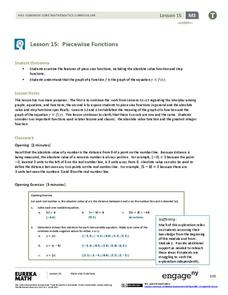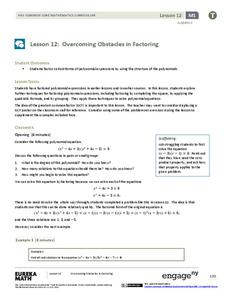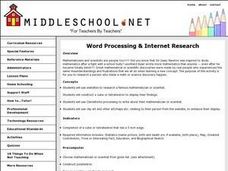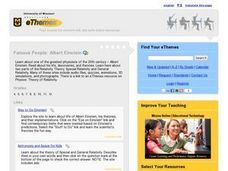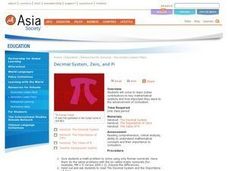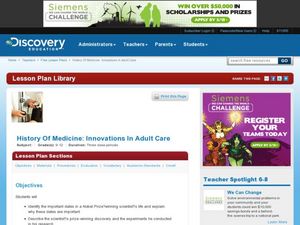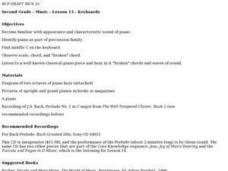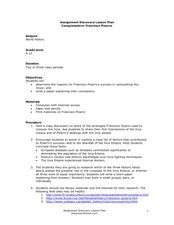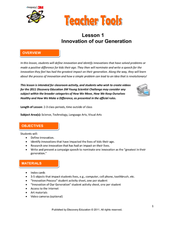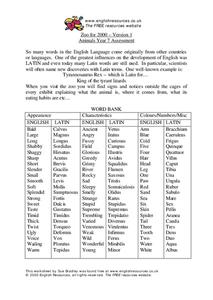EngageNY
Piecewise Functions
Show your class members that if they can graph a linear function, they can graph an absolute value function. Groups create an absolute value graph using a table, then entertain the idea of an absolute value function defined as two...
Curated OER
Genome's Greatest Hits
Pupils explore the progression of discoveries that have led to the genetics knowledge that scientists currently have. In groups, students research scientists that have made important contributions to understanding the molecules behind...
Curated OER
Dinosaur! Fossil Rush: Tale of a Bone
Explore 1870s when a "bone rush" led to amazing discoveries, as fossil-hunters risked life and limb in their quest for dinosaur remains. The class uses the attached visual encyclopedia to prep for a discussion on early paleontology. Two...
Curated OER
Innovation of Our Generation
Students identify the innovations that have impacted their lives. In this inventions instructional activity students write and present a speech on the greatest innovation of their generation.
EngageNY
Overcoming Obstacles in Factoring
What do you do when factoring doesn't work? Learners complete the square when faced with quadratic expression that don't factor traditionally. They then use factoring by grouping to solve polynomial equations.
Curated OER
Happy Birthday Mathematicians and Me
Students choose a mathematician or scientist born on the same day as the student and research them. They create a cube or tetrahedron and place required information on the sides (such as birth year, death yr., greatest contribution to...
Curated OER
Archeological Finds
Students explore archeology and it contributions to human history. They write a magazine article describing the discovery of a dig.
Curated OER
What Can You Make of It?
Students investigate the various uses of a paper cup. In this scientific inquiry lesson, students investigate various ways to use a paper cup by identifying its characteristics. Students sketch their discovery.
Curated OER
Famous People: Albert Einstein
Students research Albert Einstein and the two parts of the Relativity Theory.
Curated OER
Secrets Beneath the Waters
Learners work in small groups and design a ship out of balsa wood. They hypothesize what happens when the ship is placed in water then make predictions as to which ship stays afloat the longest with the greatest amount of weight added.
Curated OER
History: Impact of the Lewis and Clark Expedition
Students formulate theories about the Lewis and Clark Expedition about its purpose and impact on America. They write position papers supported with facts discovered in their research. Students include quotes, factual references, maps,...
Curated OER
Exploring Transformations
Students explore what happens when geometric figures are transformed on the coordinate plane. They work in pairs, moving geometric shapes in the plane, and formalize their rules as functions.
Curated OER
Decimal System, Zero, and Pi
Students explore Indian contributions to mathematics. For this mathematics history lesson, students examine the decimal system, zero, and pi as contributions from the Indian culture.
Curated OER
Innovations In Adult Care
Students study scientists and the important Nobel Prize dates. In this investigative lesson students divide into groups and watch a program then complete a project.
Curated OER
KEYBOARDS
Second graders become familiar with appearance and characteristic sound of piano, identify piano as part of percussion family, find middle C on the keyboard, observe scale, chord, and "broken" chord, and listen to a well-known classical...
Curated OER
Conquistadors: Francisco Pizarro
Learners examine the work of Spanish conquistadors. In this Inca lesson, students research factors that led to Pizzaro's conquest of the Inca and compose essays pertaining to their findings.
Curated OER
Morse Code, Telegraph, and West Virginia
Students prepare for a visit to the West Virginia State Museum. In this West Virginia history lesson, students research the Morse Code and telegraph. Students create their own Morse Code and discuss communication history prior to...
Curated OER
The Invention of Faraday Cage
Students demonstrate how Faraday's cage work by building their own electroscope. In this physics instructional activity, students explain how Faraday's cage work. They cite several applications of this principle in the real world.
Curated OER
Innovation of Our Generation
Students brainstorm on the different innovation in their lives today. For this technology lesson, students research one innovation and prepare a speech to convince their classmate to name it the "Innovation of our Generation." They...
Curated OER
Heat Absorption
Students examine how heat moves from substance to another. In this heat absorption instructional activity students identify ways that heat is transferred and analyze data.
Curated OER
the New Explorers:Into the Depths
Students explore the self preservation mechanism that is inherent in the Great Lakes. They examine how scientists are studying Great Lakes, and what their predictions are for these national treasures.
Curated OER
Lesson 1
Students understand the meaning of natural resources. They distinguish between renewable and non-renewable natural resources. To help students identify natural resources as either non-renewable or renewable. To stimulate student thinking...
Curated OER
Zoo Animals
In this zoo animals worksheet, students create five new animals and write the zoological descriptions of them following a detailed description on how to complete the assignment. Students practice using Latin words and find the animals...
